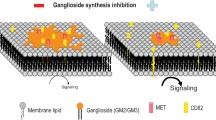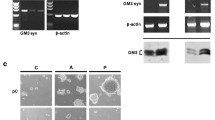Abstract
Glycosphingolipids, particularly gangliosides, are known to modulate growth factor receptor tyrosine kinase. A well-documented example is the inhibitory effect of GM3 on kinase associated with epidermal growth factor receptor (EGFR) in human epidermoid carcinoma A431 cells. Lyso-GM3 was detected as a minor component in A431 cells, and may function as an auxiliary factor in GM3-dependent inhibition of EGFR. We studied the inhibitory effect of chemically synthesized GM3, lyso-GM3, and its derivatives, on EGFR function, based on their interaction in membrane microdomain, with the following major findings: (1) GM3, EGFR, and caveolin coexist, but tetraspanins CD9 and CD82 are essentially absent, within the same low-density membrane fraction, separated by sucrose density gradient ultracentrifugation. (2) Strong interaction between EGFR and GM3 was indicated by increasing binding of EGFR to GM3-coated polystyrene beads, in a GM3 dose-dependent manner. Confocal microscopy results suggested that three components in the microdomain (GM3, EGFR, and caveolin) are closely associated. (3) Lyso-GM3 or lyso-GM3 dimer strongly inhibited EGFR kinase activity, in a dose-dependent manner, while lyso-GM3 trimer and tetramer did not. >50 μM lyso-GM3 was cytolytic, while >50 μM lyso-GM3 dimer was not cytolytic, yet inhibited EGFR kinase strongly. Thus, lyso-GM3 and its dimer exert an auxiliary effect on GM3-induced inhibition of EGFR kinase and cell growth, and lyso-GM3 dimer may be a good candidate for pharmacological inhibitor of epidermal tumor growth.










Similar content being viewed by others
Abbreviations
- DMEM:
-
Dulbecco’s modified Eagle’s medium
- EGF:
-
epidermal growth factor
- EGFR:
-
epidermal growth factor receptor
- FBS:
-
fetal bovine serum
- GFR:
-
growth factor receptor
- GM3:
-
NeuAcα3Galβ4Glcβ1Cer
- HPTLC:
-
high-performance thin-layer chromatography
- HRP:
-
horseradish peroxidase
- mAb:
-
monoclonal antibody
- MALDI-TOF MS:
-
matrix assisted laser desorption/ionization time-of-flight mass spectrometry
- PBS:
-
phosphate-buffered saline
- PNF:
-
post-nuclear fraction
- r.t.:
-
room temperature
- TBS:
-
Tris-buffered saline
References
Hakomori, S., Igarashi, Y.: Functional role of glycosphingolipids in cell recognition and signaling. J. Biochem. (Tokyo) 118, 1091–103 (1995)
Miljan, E.A., Bremer, E.G.: Regulation of growth factor receptors by gangliosides. Science STKE 2002, RE15, 1–0 (2002)
Yates, A.J., Rampersaud, A.: Sphingolipids as receptor modulators: An overview. In: Ledeen, R.W., Hakomori, S., Yates, A.J., Schneider, J.S., Yu, R.K. (eds.) Sphingolipids as signaling modulators in the nervous system, Vol. 845, pp. 57–71. Annals of the NY Academy of Sciences. New York Acad Sci, New York, NY (1998)
Ushiro, H., Cohen, S.: Identification of phosphotyrosine as a product of epidermal growth factor-activated protein kinase in A431 cell membranes. J. Biol. Chem. 255, 8363–8365 (1980)
Cohen, S., Carpenter, G., King, L.: Epidermal growth factor receptor–protein kinase interactions: co-purification of receptor and epidermal growth factor-enhanced phosphorylation activity. J. Biol. Chem. 255, 4834–4842 (1980)
Hunter, T., Cooper, J.A.: Epidermal growth factor induces rapid tyrosine phosphorylation of proteins in A431 human tumor cells. Cell 24, 741–752 (1981)
Fernandes, H., Cohen, S., Bishayee, S.: Glycosylation-induced conformational modification positively regulates receptor–receptor association: a study with an aberrant epidermal growth factor receptor (EGFRvIII/DEGFR) expressed in cancer cells. J. Biol. Chem. 276, 5375–5383 (2001)
Bremer, E.G., Schlessinger, J., Hakomori, S.: Ganglioside-mediated modulation of cell growth: Specific effects of GM3 on tyrosine phosphorylation of the epidermal growth factor receptor. J. Biol. Chem. 261, 2434–2440 (1986)
Hanai, N., Nores, G.A., MacLeod, C., Torres-Mendez, C.-R., Hakomori, S.: Ganglioside-mediated modulation of cell growth: specific effects of GM3 and lyso-GM3 in tyrosine phosphorylation of the epidermal growth factor receptor. J. Biol. Chem. 263, 10915–10921 (1988)
Wang, X.-Q., Sun, P., O’Gorman, M., Tai, T., Paller, A.S.: Epidermal growth factor receptor glycosylation is required for ganglioside GM3 binding and GM3-mediated suppression of activation. Glycobiology 11, 515–522 (2001)
Yoon, S., Nakayama, K., Hikita, T., Handa, K., Hakomori, S.: Epidermal growth factor receptor tyrosine kinase is modulated by GM3 interaction with N-linked GlcNAc termini of the receptor. Proc. Natl. Acad. Sci. U S A 103, 18987–18991 (2006)
Hanai, N., Nores, G.A., Torres-Mendez, C.-R., Hakomori, S.: Modified ganglioside as a possible modulator of transmembrane signaling mechanism through growth factor receptors: A preliminary note. Biochem. Biophys. Res. Commun. 147, 127–34 (1987)
Dohi, T., Nores, G., Hakomori, S.: An IgG3 monoclonal antibody established after immunization with GM3 lactone: immunochemical specificity and inhibition of melanoma cell growth in vitro and in vivo. Cancer Res. 48, 5680–5685 (1988)
Yamamura, S., Handa, K., Hakomori, S.: A close association of GM3 with c-Src and Rho in GM3-enriched microdomains at the B16 melanoma cell surface membrane: A preliminary note. Biochem. Biophys. Res. Commun. 236, 218–222 (1997)
Iwabuchi, K., Yamamura, S., Prinetti, A., Handa, K., Hakomori, S.: GM3-enriched microdomain involved in cell adhesion and signal transduction through carbohydrate–carbohydrate interaction in mouse melanoma B16 cells. J. Biol. Chem. 273, 9130–9138 (1998)
Todeschini, A.R., Dos Santos, J.N., Handa, K., Hakomori, S.: Ganglioside GM2-tetraspanin CD82 complex inhibits Met and its cross-talk with integrins, providing a basis for control of cell motility through glycosynapse. J. Biol. Chem. 282, 8123–8133 (2007)
Kawamoto, T., Sato, J.D., Le, A., Polikoff, J., Sato, G.H., Mendelsohn, J.: Growth stimulation of A431 cells by epidermal growth factor: identification of high-affinity receptors for epidermal growth factor by an anti-receptor monoclonal antibody. Proc. Natl. Acad. Sci. U S A 80, 1337–1341 (1983)
Ono, M., Handa, K., Sonnino, S., Withers, D.A., Nagai, H., Hakomori, S.: GM3 ganglioside inhibits CD9-facilitated haptotactic cell motility: co-expression of GM3 and CD9 is essential in down-regulation of tumor cell motility and malignancy. Biochemistry 40, 6414–6421 (2001)
Kawakami, Y., Kawakami, K., Steelant, W.F.A., Ono, M., Baek, R.C., Handa, K., Withers, D.A., Hakomori, S.: Tetraspanin CD9 is a “proteolipid”, and its interaction with a3 integrin in microdomain is promoted by GM3 ganglioside, leading to inhibition of laminin-5-dependent cell motility. J. Biol. Chem. 277, 34349–34358 (2002)
Mitsuzuka, K., Handa, K., Satoh, M., Arai, Y., Hakomori, S.: A specific microdomain (“glycosynapse 3”) controls phenotypic conversion and reversion of bladder cancer cells through GM3-mediated interaction of alpha3beta1 integrin with CD9. J. Biol. Chem. 280, 35545–35553 (2005)
Zhou, Q., Hakomori, S., Kitamura, K., Igarashi, Y.: GM3 directly inhibits tyrosine phosphorylation and de-N-acetyl-GM3 directly enhances serine phosphorylation of epidermal growth factor receptor, independently of receptor–receptor interaction. J. Biol. Chem. 269, 1959–1965 (1994)
Bremer, E.G., Hakomori, S., Bowen-Pope, D.F., Raines, E.W., Ross, R.: Ganglioside-mediated modulation of cell growth, growth factor binding, and receptor phosphorylation. J. Biol. Chem. 259, 6818–6825 (1984)
Yates, A.J., VanBrocklyn, J., Saqr, H.E., Guan, Z., Stokes, B.T., O’Dorisio, M.S.: Mechanisms through which gangliosides inhibit PDGF-stimulated mitogenesis in intact Swiss 3T3 cells: Receptor tyrosine phosphorylation, intracellular calcium, and receptor binding. Exp. Cell. Res. 204, 38–45 (1993)
Nojiri, H., Stroud, M.R., Hakomori, S.: A specific type of ganglioside as a modulator of insulin-dependent cell growth and insulin receptor tyrosine kinase activity: Possible association of ganglioside-induced inhibition of insulin receptor function and monocytic differentiation induction in HL60 cells. J. Biol. Chem. 266, 4531–4537 (1991)
Tagami, S., Inokuchi, J., Kabayama, K., Yoshimura, H., Kitamura, F., Uemura, S., Ogawa, C., Ishii, A., Saito, M., Ohtsuka, Y., Sakaue, S., Igarashi, Y.: Ganglioside GM3 participates in the pathological conditions of insulin resistance. J. Biol. Chem. 277, 3085–3092 (2002)
Yamashita, T., Hashiramoto, A., Haluzik, M., Mizukami, H., Beck, S., Norton, A., Kono, M., Tsuji, S., Daniotti, J.L., Werth, N., Sandhoff, R., Sandhoff, K., Proia, R.L.: Enhanced insulin sensitivity in mice lacking GM3 ganglioside. Proc. Natl. Acad. Sci. U S A 100, 3445–3449 (2003)
Mutoh, T., Tokuda, A., Miyada, T., Hamaguchi, M., Fujiki, N.: Ganglioside GM1 binds to the Trk protein and regulates receptor function. Proc. Natl. Acad. Sci. U S A 92, 5087–5091 (1995)
Mutoh, T., Hamano, T., Yano, S., Koga, H., Yamamoto, H., Furukawa, K., Ledeen, R.W.: Stable transfection of GM1 synthase gene into GM1-deficient NG108-15 cells, CR-72 cells, rescues the responsiveness of Trk-neurotrophin receptor to its ligand, NGF. Neurochem. Res. 27, 801–806 (2002)
Sorice, M., Parolini, I., Sansolini, T., Garofalo, T., Dolo, V., Sargiacomo, M., Tai, T., Peschle, C., Torrisi, M.R., Pavan, A.: Evidence for the existence of ganglioside-enriched plasma membrane domains in human peripheral lymphocytes. J. Lipid. Res. 38, 969–980 (1997)
Hakomori, S., Yamamura, S., Handa, K.: Signal transduction through glyco(sphingo)lipids: introduction and recent studies on glyco(sphingo)lipid-enriched microdomains. In: Ledeen, R.W., Hakomori, S., Yates, A.J., Schneider, J.S., Yu, R.K. (eds.) Sphingolipids as signaling modulators in the nervous system, Vol. 845, pp. 1–10. Annals of the NY Academy of Sciences. NY Academy of Sciences, New York, NY, (1998)
Hakomori, S.: Cell adhesion/recognition and signal transduction through glycosphingolipid microdomain. Glycoconj. J. 17, 143–151 (2000)
Gourier, C., Pincet, F., Perez, E., Zhang, Y., Zhu, Z., Mallet, J.M., Sinay, P.: The natural LewisX-bearing lipids promote membrane adhesion: influence of ceramide on carbohydrate–carbohydrate recognition. Angew. Chem. Angew. Chem. Int. Ed. Engl. Suppl. 44, 1683–1687 (2005)
Iwabuchi, K., Zhang, Y., Handa, K., Withers, D.A., Sinaÿ, P., Hakomori, S.: Reconstitution of membranes simulating “glycosignaling domain” and their susceptibility to lyso-GM3. J. Biol. Chem. 275, 15174–15181 (2000)
Lee, Y.C.: Biochemistry of carbohydrate–protein interaction. FASEB J. 6, 3193–3200 (1992)
Bellezza, I, Bracarda, S, Caserta, C, Minelli, A: Targeting of EGFR tyrosine kinase by ZD1839 (“Iressa”) in androgen-responsive prostate cancer in vitro. Mol. Genet. Metab. 88, 114–122 (2006)
Sui, G., Bonde, P., Dhara, S., Broor, A., Wang, J., Marti, G.: Epidermal growth factor receptor and hedgehog signaling pathways are active in esophageal cancer cells from rat reflux model. J. Surg. Res. 134, 1–9 (2006)
Czito, B.G., Willett, C.G., Bendell, J.C., Morse, M.A., Tyler, D.S., Fernando, N.H., Mantyh, C.R., Blobe, G.C., Honeycutt, W., Yu, D., Clary, B.M., Pappas, T.N., Ludwig, K.A., Hurwitz, H.I.: increased toxicity with gefitinib, capecitabine, and radiation therapy in pancreatic and rectal cancer: phase I trial results. J. Clin. Oncol. 24, 656–662 (2006)
Reardon, D.A., Quinn, J.A., Vredenburgh, J.J., Gururangan, S., Friedman, A.H., Desjardins, A., Sathornsumetee, S., Herndon, J.E. 2nd, Dowell, J.M., McLendon, R.E., Provenzale, J.M., Sampson, J.H., Smith, R.P., Swaisland, A.J., Ochs, J.S., Lyons, P., Tourt_Uhlig, S., Bigner, D.D., Friedman, H.S., Rich, J.N.: Phase 1 trial of gefitinib plus sirolimus in adults with recurrent malignant glioma. Clin. Cancer. Res. 12, 860–868 (2006)
Magnani, JL: The discovery, biology, and drug development of sialyl Lea and sialyl Lex. Arch. Biochem. Biophys. 426, 122–131 (2004)
Acknowledgements
This study was supported in part by NIH/ National Cancer Institute grant R01 CA080054 to SH.
Author information
Authors and Affiliations
Corresponding authors
Rights and permissions
About this article
Cite this article
Murozuka, Y., Watanabe, N., Hatanaka, K. et al. Lyso-GM3, its dimer, and multimer: their synthesis, and their effect on epidermal growth factor-induced receptor tyrosine kinase. Glycoconj J 24, 551–563 (2007). https://doi.org/10.1007/s10719-007-9051-2
Received:
Revised:
Accepted:
Published:
Issue Date:
DOI: https://doi.org/10.1007/s10719-007-9051-2




